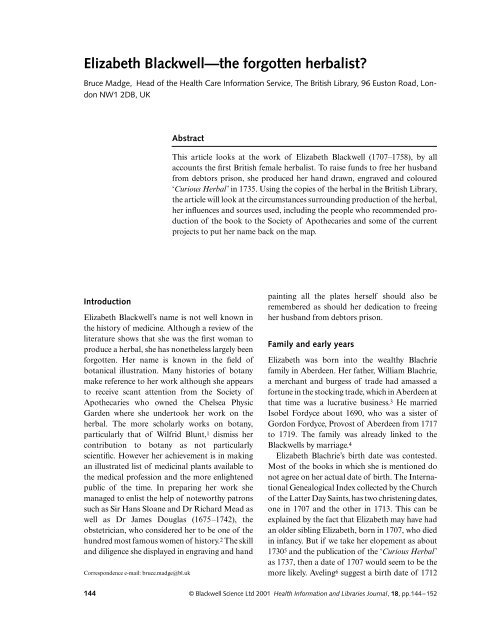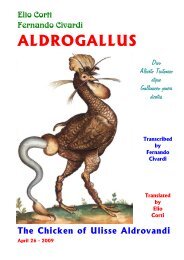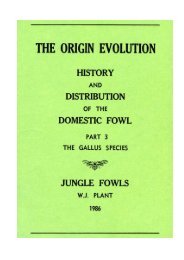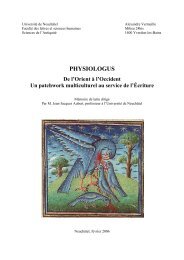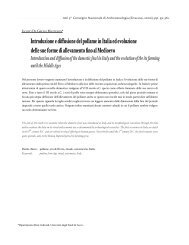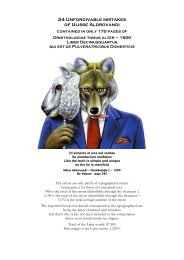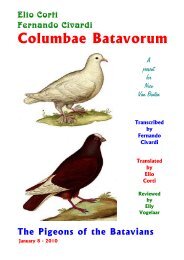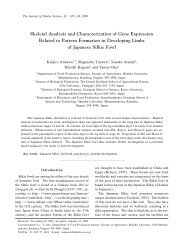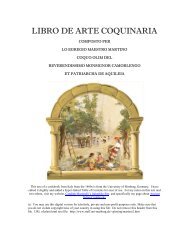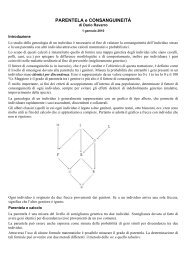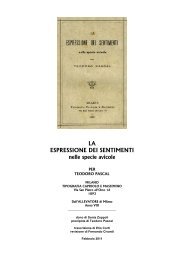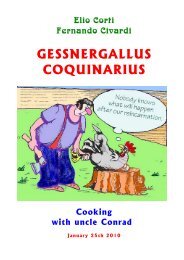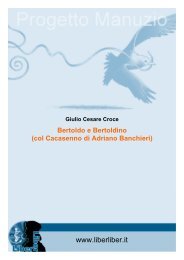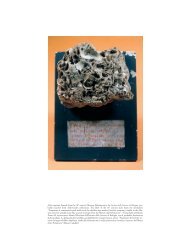Elizabeth Blackwell—the forgotten herbalist?
Elizabeth Blackwell—the forgotten herbalist?
Elizabeth Blackwell—the forgotten herbalist?
Create successful ePaper yourself
Turn your PDF publications into a flip-book with our unique Google optimized e-Paper software.
Blackwell Science, Ltd<br />
<strong>Elizabeth</strong> <strong>Blackwell—the</strong> <strong>forgotten</strong> <strong>herbalist</strong>?<br />
Bruce Madge, Head of the Health Care Information Service, The British Library, 96 Euston Road, London<br />
NW1 2DB, UK<br />
Introduction<br />
Abstract<br />
<strong>Elizabeth</strong> Blackwell’s name is not well known in<br />
the history of medicine. Although a review of the<br />
literature shows that she was the first woman to<br />
produce a herbal, she has nonetheless largely been<br />
<strong>forgotten</strong>. Her name is known in the field of<br />
botanical illustration. Many histories of botany<br />
make reference to her work although she appears<br />
to receive scant attention from the Society of<br />
Apothecaries who owned the Chelsea Physic<br />
Garden where she undertook her work on the<br />
herbal. The more scholarly works on botany,<br />
particularly that of Wilfrid Blunt, 1 dismiss her<br />
contribution to botany as not particularly<br />
scientific. However her achievement is in making<br />
an illustrated list of medicinal plants available to<br />
the medical profession and the more enlightened<br />
public of the time. In preparing her work she<br />
managed to enlist the help of noteworthy patrons<br />
such as Sir Hans Sloane and Dr Richard Mead as<br />
well as Dr James Douglas (1675–1742), the<br />
obstetrician, who considered her to be one of the<br />
hundred most famous women of history. 2 The skill<br />
and diligence she displayed in engraving and hand<br />
Correspondence e-mail: bruce.madge@bl.uk<br />
This article looks at the work of <strong>Elizabeth</strong> Blackwell (1707–1758), by all<br />
accounts the first British female <strong>herbalist</strong>. To raise funds to free her husband<br />
from debtors prison, she produced her hand drawn, engraved and coloured<br />
‘Curious Herbal’ in 1735. Using the copies of the herbal in the British Library,<br />
the article will look at the circumstances surrounding production of the herbal,<br />
her influences and sources used, including the people who recommended production<br />
of the book to the Society of Apothecaries and some of the current<br />
projects to put her name back on the map.<br />
painting all the plates herself should also be<br />
remembered as should her dedication to freeing<br />
her husband from debtors prison.<br />
Family and early years<br />
<strong>Elizabeth</strong> was born into the wealthy Blachrie<br />
family in Aberdeen. Her father, William Blachrie,<br />
a merchant and burgess of trade had amassed a<br />
fortune in the stocking trade, which in Aberdeen at<br />
that time was a lucrative business. 3 He married<br />
Isobel Fordyce about 1690, who was a sister of<br />
Gordon Fordyce, Provost of Aberdeen from 1717<br />
to 1719. The family was already linked to the<br />
Blackwells by marriage. 4<br />
<strong>Elizabeth</strong> Blachrie’s birth date was contested.<br />
Most of the books in which she is mentioned do<br />
not agree on her actual date of birth. The International<br />
Genealogical Index collected by the Church<br />
of the Latter Day Saints, has two christening dates,<br />
one in 1707 and the other in 1713. This can be<br />
explained by the fact that <strong>Elizabeth</strong> may have had<br />
an older sibling <strong>Elizabeth</strong>, born in 1707, who died<br />
in infancy. But if we take her elopement as about<br />
1730 5 and the publication of the ‘Curious Herbal’<br />
as 1737, then a date of 1707 would seem to be the<br />
more likely. Aveling 6 suggest a birth date of 1712<br />
144 © Blackwell Science Ltd 2001 Health Information and Libraries Journal, 18, pp.144–152
which would correspond to the 1713 christening<br />
date and also mentions that <strong>Elizabeth</strong> died in 1770<br />
aged 58, although other sources point to her death<br />
as being in 1758.<br />
Her father’s wealth meant that the children of<br />
the Blachrie family received a good education and<br />
his daughters a substantial dowry. Her education<br />
in the early eighteenth century would have certainly<br />
included art, music and languages which <strong>Elizabeth</strong><br />
was later to use to great effect in her herbal.<br />
Alexander Blackwell<br />
Alexander Blackwell, <strong>Elizabeth</strong>’s second cousin,<br />
was born in 1709 in Aberdeen. His father Thomas<br />
Blackwell (1660–1728) was born in Paisley but<br />
moved to Aberdeen where, after being Professor<br />
of Divinity at Marischal College, he eventually<br />
became Principal to the University. Alexander’s<br />
brother, Thomas, became Professor of Greek at<br />
the Marischal College. Alexander was something<br />
of an enigma. As a youth he conformed to the<br />
family’s rigid academic pattern but had inherited<br />
from his grandfather, a Covenanter, a love of<br />
freedom and independence.<br />
Consequently, before completing his studies at<br />
Marischal College (where he is recorded as a student<br />
between 1722 and 1726), Alexander eloped with<br />
his second cousin <strong>Elizabeth</strong> Blachrie and they were<br />
married and moved to London. This must have<br />
caused great consternation amongst Aberdeen’s<br />
dour and puritanical populace. An article in The Bath<br />
Journal of 1747 describes <strong>Elizabeth</strong> as ‘a virtuous<br />
gentlewoman, the daughter of a worthy merchant’<br />
who gave his daughter a ‘handsome portion’. 5<br />
Wyness 4 suggests that Alexander and <strong>Elizabeth</strong><br />
moved to Leiden, the centre of medical education<br />
at that time, where Alexander studied with the<br />
great Herman Boerhaave. According to Blackwell<br />
himself, he graduated in medicine from Leiden and<br />
moved back to London. However this account is<br />
not corroborated by the article in The Bath Journal<br />
of 1747 written by one ‘G.J.’ 5 a friend of the Blackwells<br />
who presumably knew the story firsthand.<br />
Background to the ‘Curious Herbal’<br />
During the return journey to London Alexander<br />
made the acquaintance of the Swedish Ambassador,<br />
© Blackwell Science Ltd 2001 Health Information and Libraries Journal, 18, pp.144–152<br />
<strong>Elizabeth</strong> Blackwell the <strong>forgotten</strong> <strong>herbalist</strong>, Bruce Madge<br />
at the Hague, who was later to play an important<br />
part in his life. Both Aveling and Delacoux record<br />
that, in order to assist her husband in his medical<br />
practice, <strong>Elizabeth</strong> Blackwell started studying as a<br />
midwife with William Smellie. 6,7 Later in her life<br />
she decided to give this up due to ‘the ignorance<br />
and low character of the women who at that time<br />
followed the same calling’. 6 However, it is possible<br />
that there were two <strong>Elizabeth</strong> Blackwells in<br />
London at the time, one of whom was our<br />
<strong>herbalist</strong> and the other the midwife referred to<br />
by William Smellie in a letter to Alexander Munro<br />
at Edinburgh. 8<br />
Although it has been stated that Alexander had<br />
studied medicine in Leiden, this is called into question<br />
by the fact that on their return to London,<br />
Alexander set up as a proof reader in the printing<br />
house of William Wilkins, a well known printer.<br />
Later, in 1730, Alexander set up as a printer in his<br />
own right in the Strand but met with hostile opposition<br />
from a group of rival printers, who considered<br />
that he had not had a proper apprenticeship. He<br />
fell into debt and was committed for 2 years to<br />
Highgate Prison.<br />
At this point his wife, <strong>Elizabeth</strong>, who was<br />
described as an ‘ingenious lady’ decided to pay off<br />
his debts and secure his release. <strong>Elizabeth</strong> had<br />
received some training in drawing and painting,<br />
whilst living with her family in Aberdeen. She had<br />
excelled in this, and she had also shared her<br />
brother Alexander’s love of botany. She now put<br />
her undoubted talents to use.<br />
Influences and sources used by <strong>Elizabeth</strong><br />
Blackwell<br />
Sir Hans Sloane (1660–1753)<br />
Sir Hans Sloane was a British physician and<br />
botanist, born in Ireland of Scottish descent. He<br />
trained in medicine in London and also went<br />
abroad to study chemistry. He studied botany at<br />
the Chelsea Physic Garden in 1679 with John Ray.<br />
He was elected as a fellow of the Royal Society in<br />
1684 and succeeded Sir Isaac Newton as president<br />
in 1712. He travelled to Jamaica with the Duke<br />
of Albemarle and accumulated much botanical<br />
material, bringing back about 800 specimens to<br />
London. In 1694 he was made Physician to<br />
145
146<br />
<strong>Elizabeth</strong> Blackwell the <strong>forgotten</strong> <strong>herbalist</strong>, Bruce Madge<br />
Christ’s Hospital, a post which he held for<br />
30 years. He published a catalogue of his Jamaican<br />
plants in 1696 and this was later incorporated into<br />
Ray’s Historia with Sloane’s blessing. In 1712,<br />
Sloane purchased the Manor of Chelsea from<br />
Lord Cheyne and after several years of protracted<br />
negotiations, the freehold was transferred to<br />
the Society of Apothecaries in 1722. He became a<br />
baronet in 1716 and in 1727 was appointed George<br />
II’s physician. After his death in 1753, his private<br />
collections and library provided the foundation<br />
of the British Museum.<br />
The Chelsea Physic Garden (see Figure 1)<br />
Since 1673, the Society of Apothecaries had rented<br />
four acres of Chelsea waterside from Lord Cheyne.<br />
A gardener had been appointed and plants<br />
transferred from the Westminster herb garden of<br />
William Gape, a Past Master of the Society. In<br />
1676 a wall was built around the property, which<br />
still survives today, and four Cedars of Lebanon<br />
were planted flanking the river gate. The last of<br />
these magnificent trees died in 1904 and was made<br />
into chairs for the Master and Wardens. John<br />
Watts was appointed gardener in 1675 and,<br />
according to John Evelyn, may have erected the<br />
first English greenhouse. However financial<br />
problems meant that the Society was unable to<br />
pay for the freehold of the land (about £400)<br />
which is when Sir Hans Sloane stepped in to save<br />
the Garden. A grateful Society erected a statue<br />
to Sir Hans, sculpted by Rysbrack in 1738, which<br />
still stands in the centre of the Garden. 9<br />
Dr Richard Mead (1673–1754)<br />
Figure 1 View of Chelsea Physic<br />
Garden from the River Thames 1795<br />
Dr Richard Mead was a physician known for<br />
his suavity who, according to Dr Johnson ‘lived<br />
more in the broad sunshine of life than almost any<br />
other man’. He is best known for his work on the<br />
plague in London, speaking out against the<br />
abolition of quarantine, and supporting Lady<br />
Mary Wortley Montague and her demand for<br />
inoculation for smallpox. As with many eighteenth<br />
century physicians he was a great collector of art<br />
and had a large library; he also wrote a book on<br />
medical practice in the Bible. He tried to diffuse<br />
the antagonism between the apothecaries and the<br />
physicians by arranging meetings between the two<br />
groups at Tom’s, a coffee house near Covent<br />
Garden, where he discussed cases and saw<br />
patients, all of which added to his fame and<br />
fortune. 10<br />
The Gardeners—Isaac Rand and Philip Miller<br />
Isaac Rand was a member of the Society of<br />
Apothecaries and was employed as ‘Praefectus<br />
horti and Demonstrator of Plants’ at Chelsea. He<br />
was one of the people who recommended<br />
<strong>Elizabeth</strong>’s book and gave her great assistance<br />
and encouragement when she was producing<br />
her work.<br />
© Blackwell Science Ltd 2001 Health Information and Libraries Journal, 18, pp.144–152
Figure 2 The Wood Strawberry<br />
Sir Hans Sloane introduced Philip Miller<br />
(1691–1771) as gardener to the Society. He was<br />
the first to suggest the part played by insects in<br />
the fertilization of plants and was the author of The<br />
Gardener’s Dictionary. 11 He busied himself with<br />
introducing rare plants into the garden and wrote<br />
to many botanists around the world to obtain<br />
specimens. He also suggested that cotton might<br />
be grown in the new American colony of Georgia<br />
which led to the cotton trade in the United States.<br />
Linnaeus himself visited Miller at the Garden<br />
and collected many specimens and, although<br />
they quarrelled at one point, the Garden was<br />
rearranged along lines corresponding to Linnaeus’s<br />
classification scheme.<br />
Production and publication of the<br />
‘Curious Herbal’<br />
Natural history in the eighteenth century was seen<br />
as a suitable occupation for a lady. Maria Sibylla<br />
Merian, who was born in Frankfurt in 1647,<br />
had published her Neues Blumen Buch in 1680, a<br />
© Blackwell Science Ltd 2001 Health Information and Libraries Journal, 18, pp.144–152<br />
<strong>Elizabeth</strong> Blackwell the <strong>forgotten</strong> <strong>herbalist</strong>, Bruce Madge<br />
catalogue of her hand-painted engravings of<br />
garden flowers intended as models for embroidery<br />
and silk painting. 12 It is likely that <strong>Elizabeth</strong><br />
Blackwell saw this book.<br />
Botany in particular was recommended for<br />
ladies although the Reverend Richard Polwhele in<br />
his ‘poetic’ diatribe against the feminist Mary<br />
Wollstonecraft, was less sure:<br />
‘Botany has lately become a fashionable<br />
amusement with the ladies. But how the study of<br />
the sexual system of plants can accord with female<br />
modesty, I am not able to comprehend ... I have,<br />
several times, seen boys and girls botanizing<br />
together’. 13<br />
<strong>Elizabeth</strong> set to work making some preliminary<br />
drawings of medicinal herbs which she submitted<br />
to Sir Hans Sloane and Dr Richard Mead. Both<br />
were impressed with her work and urged her to<br />
continue with a view to publication.<br />
Having gained the approval of these famous<br />
medical men, <strong>Elizabeth</strong> Blackwell took lodgings at<br />
Swan Walk, next to the Chelsea Physic Garden, so<br />
that she might be close to the subjects of her work.<br />
A rate list of the time assigns no. 4, Swan Walk to<br />
Alexander Blackwell from 1736 to 1739. 14 The<br />
proximity of the Garden where ‘she had an opportunity<br />
of receiving the plants, flowers, etc. fresh out<br />
of the garden, from time to time, as she wanted<br />
them’ was obviously a bonus for a botanical artist.<br />
However, the task was enormous and became a<br />
labour of many years, as she drew the plants,<br />
engraved them and coloured them by hand (Fig. 2).<br />
She also engraved the text. The scientific nomenclature<br />
and foreign names were supplied by her husband<br />
from his prison cell. Some of the plants were<br />
copied from H.A. van Rheede tot Draakestein’s<br />
Hortus indicus malabaricus, although <strong>Elizabeth</strong> was<br />
very careful to assign these plates to him.<br />
‘A Curious Herbal, containing five hundred cuts<br />
of the most useful plants which are now used in<br />
the Practise of Physick, to which is added a short<br />
description of ye plants and their common uses<br />
in Physick’ 15 was issued in weekly parts, each<br />
containing four plates and accompanying text<br />
over 125 weeks between 1737 and 1739. The first<br />
volume contained 250 plates and was published<br />
in 1737. The imprint read ‘London printed for<br />
147
148<br />
<strong>Elizabeth</strong> Blackwell the <strong>forgotten</strong> <strong>herbalist</strong>, Bruce Madge<br />
Figure 3 Frontispiece to A Curious Herbal<br />
Samuel Harding in St Martin’s Lane’ and the new<br />
publication was announced in the Gentleman’s<br />
Magazine for July 1737.<br />
<strong>Elizabeth</strong> Blackwell herself was allowed to<br />
present a copy to the College of Physicians who ‘so<br />
greatly approved of it that they not only made her<br />
a handsome present, but also gave her an ample<br />
testimonial, in writing, of their approbation of<br />
her work’ (Fig. 3). Although no account of the<br />
‘handsome present’ can be found in the accounts<br />
of the College of Physicians, 14 it is assumed that<br />
this is the commendation dated 1st July 1737,<br />
which is found in most copies of the work with the<br />
names of the President of the Royal College of<br />
Physicians, Thomas Pellet and the four censors—<br />
Henry Plumptre, Richard Tyson, Pierce Dod and<br />
William Wasey. The commendation has an engraving<br />
of Theophrastus and Dioscorides (Fig. 3), considered<br />
to be the fathers of botany, seated with a<br />
coat of arms between them. The arms, intended to<br />
be those of the Royal College of Physicians, are<br />
encircled by a Greek motto which translates as:<br />
‘Medicine while these (i.e. herbs) flourish, flourishes<br />
Figure 4 <strong>Elizabeth</strong> Blackwell, c. 1737 (from a print in the<br />
British Museum)<br />
with them’. In a scroll below the arms is a Greek<br />
motto signifying that ‘Drugs are the hands of God’.<br />
The motto, legend and the arms of the College of<br />
Physicians are to be found in the first edition of<br />
the Pharmacopoeia Londinensis of 1618. 16 Although<br />
the arms are meant to be those of the College, there<br />
are in fact two mistakes—the arm is reversed and<br />
a pomegranate is represented as a thistle.<br />
The second volume appeared in 1739, although<br />
no contemporary advertisement for it exists. The<br />
Country Journal: or the Craftsman for 6th May<br />
1738 records the publication of the first volume of<br />
252 plates of plants. It noted further that ‘a further<br />
132 plates of plants for the second volume’ had<br />
been published and that ‘the whole 500 will be<br />
finished in eight months’; a dedication to Dr John<br />
Johnstoun is dated the 17th January 1739. The<br />
advertisement in The Country Journal closes<br />
with a warning against ‘a spurious and base<br />
copy’ of the work sold by Samuel Harding, one of<br />
which had been sold by the print sellers and<br />
engravers: George Bickham Jnr, Philip Overton,<br />
John King, Thomas Bakewell, John Tinney,<br />
Samuel Simpson, Stephen Lye and Thomas<br />
Harper. They had apparently copied some of<br />
<strong>Elizabeth</strong> Blackwell’s plates and Alexander<br />
Blackwell took great delight in prosecuting them<br />
as they had prosecuted him! 17<br />
<strong>Elizabeth</strong>’s plan worked and, using the proceeds<br />
from the sales of the herbal, she freed her husband<br />
from prison by paying his debtors. Between 1737<br />
© Blackwell Science Ltd 2001 Health Information and Libraries Journal, 18, pp.144–152
and 1747, Alexander Blackwell and his wife made<br />
several transactions with John Nourse, a bookseller<br />
near Temple Bar in London, which are preserved<br />
in the manuscript collections of the British<br />
Library. Briefly they were as follows:<br />
1 On 28th September 1737 ‘Alexander Blackwell<br />
of Chelsea’ with the consent of his wife <strong>Elizabeth</strong>,<br />
sold a third share of the herbal, which was to contain<br />
figures of plants engraved on 500 copperplates<br />
and engraved descriptive text on a further<br />
125 copper plates to Nourse for the sum of £150,<br />
and in order that Blackwell could not produce a<br />
copy of the work without Nourse’s consent, he,<br />
Blackwell, had to give Nourse a third of the plates.<br />
Nourse paid Blackwell with two notes for £75,<br />
‘each payable 12 months after date’ one of which<br />
was dated 28th September 1737 and the other 8th<br />
February 1738.<br />
2 In a deed of 19th February 1739 ‘Alexander<br />
Blackwell of Stanmore in the county of Middlesex’<br />
assigned to Nourse the entire copyright of the<br />
herbal for £150 and a mortgage for £169. 4 s 1d<br />
(which Blackwell owed to Nourse). Nourse was<br />
then to recover the £169. 4 s 1d out of publishing<br />
the work and when fully repaid, Nourse would<br />
reconvey two-thirds of the copyright to Blackwell.<br />
3 On 2nd October 1740, the Blackwells sold a<br />
further sixth share of the copyright to Nourse for<br />
£75. 0 s 0d. making Nourse the copyright holder<br />
of half of the work.<br />
4 On 5th December 1745 Alexander Blackwell,<br />
then residing in Ållestad near Gothenburg in Sweden<br />
granted his wife, who was at that time living ‘in<br />
the parish of St Paul Covent Garden in the county<br />
of Middlesex’, power of attorney to act for him in<br />
his business dealings with Nourse and others. Subsequently<br />
on 28th April 1747, <strong>Elizabeth</strong> Blackwell,<br />
as so empowered, wrote an acknowledgement that<br />
she had received £20 from Nourse and that this,<br />
with £108. 13 s 0d already owing to Nourse on<br />
account of her herbal, was the consideration for<br />
transferring to him all her rights in her remaining<br />
half share of her work entitled A curious herbal<br />
(containing 625 plates ‘and upwards’), all copies of<br />
the said book both coloured and uncoloured then<br />
remaining unsold in Nourse’s hands, and all the<br />
copper plates. 18<br />
There is an entry in Blackwell’s account with<br />
Nourse which is dated 12th March 1739 and which<br />
© Blackwell Science Ltd 2001 Health Information and Libraries Journal, 18, pp.144–152<br />
<strong>Elizabeth</strong> Blackwell the <strong>forgotten</strong> <strong>herbalist</strong>, Bruce Madge<br />
refers to £11. 4 s 2d received by Blackwell as the<br />
balance from ‘Mr Harding’ which possibly indicates<br />
the date on which the agreement between<br />
Blackwell and the bookseller Samuel Harding was<br />
ended. It appears that Nourse was more willing<br />
than Harding to loan Blackwell money and on<br />
28th April 1747, the remaining half share of the<br />
herbal was sold to Nourse as settlement of an<br />
outstanding debt.<br />
The success of ‘A Curious Herbal’ may be partly<br />
due to the fact that there was a need for such a<br />
work, which is one of the reasons advanced that<br />
Sir Hans Sloane and Richard Mead backed the<br />
publication of the work. However, on closer examination,<br />
there were two other works that covered<br />
very similar ground albeit both were over 10 years<br />
old. In 1723, Patrick Blair, a Fellow of the Royal<br />
Society, had published ‘Pharmaco-Botanologia:<br />
or An Alphabetical and Classical Dissertation on<br />
all the British Indigenous and Garden Plants of<br />
the New London Dispensatory ...’ 19 and a year<br />
earlier Joseph Miller, also of the Chelsea Physic<br />
Garden, had published ‘Botanicum Officinale; or<br />
a Compendious Herbal: giving an account of all<br />
such plants as are now used in the Practice of<br />
Physick’. 20 Joseph Miller’s book played a major<br />
part in the production of A Curious Herbal as many<br />
of the descriptions of medical properties are taken<br />
from it. The main drawback with these publications<br />
was that they were not illustrated, so Sir<br />
Hans Sloane may have felt that an illustrated<br />
herbal was called for.<br />
It is likely that Sloane supported the publication<br />
of <strong>Elizabeth</strong> Blackwell’s book as he wanted to<br />
ensure that the plants he had described and<br />
brought back from Jamaica were included in any<br />
new herbal published and their medicinal properties<br />
investigated. It is also true that recommendations<br />
from apothecaries, botanists and physicians<br />
helped to advance sales of the Curious Herbal.<br />
It was re-issued as two folio volumes in 1739,<br />
1751 and 1782. The work is also noteworthy for<br />
the number of dedications contained in varying<br />
numbers depending on the version of the publication.<br />
They are addressed to eminent apothecaries<br />
and physicians who gave the author assistance and<br />
encouragement. They include not only Richard<br />
Mead, Sir Hans Sloane and Isaac Rand but also<br />
Thomas Pellett, President of the Royal College of<br />
149
150<br />
<strong>Elizabeth</strong> Blackwell the <strong>forgotten</strong> <strong>herbalist</strong>, Bruce Madge<br />
Physicians; Alexander Stuart, the physician who<br />
‘showed some of the first drawings at a public<br />
herbarizing of the worshipful Company of apothecaries’;<br />
14 the physician and botanist James Douglas<br />
and the aforementioned Joseph Miller. There is<br />
also a mention of John Johnstoun, Professor of<br />
Medicine of the University of Glasgow from 1714<br />
to 1750, who was <strong>Elizabeth</strong>’s uncle. The acknowledgement<br />
for him reads:<br />
‘As this work has met with a more favourable<br />
reception from the publick, both at home and<br />
abroad, than I could have expected, knowing my<br />
own insufficiency for the undertaking; this success<br />
must be ascrib’d in great measure to the prevailing<br />
influence of those worthy gentlemen, who kindly<br />
honoured it by their recommendation, amongst<br />
them, I am in a particular manner indebted to<br />
your goodness, in making it acceptable at<br />
Glasgow’ and is signed ‘your much obliged niece.<br />
<strong>Elizabeth</strong> Blackwell’. 14<br />
In 1806, many years later, the botanical writer<br />
Richard Weston wrote ‘This work still continues in<br />
such esteem as to keep up its original price of six<br />
or seven guineas, and 10 on large paper, in the<br />
modern sale catalogues’. 17<br />
The book itself contained the most comprehensive<br />
collection of pictures of medicinal plants<br />
available at that time and was only bettered by the<br />
publication in 1790–1795, of William Woodville’s<br />
Medicinal Botany. Although there was criticism,<br />
by later generations, that the plants seemed stiff<br />
and unnatural, had large areas of blank space, and<br />
a simplified approach, it was an undertaking of<br />
heroic proportions.<br />
It is also interesting to note that a comparison<br />
with both Gerard’s and Parkinson’s herbals from<br />
the previous century, indicate St John’s Wort as a<br />
wound cure whereas by the time of the publication<br />
of Miller’s book it was being used to treat melancholy,<br />
for which purpose it is still used today.<br />
Between 1747 and 1773, an enlarged and<br />
improved version of <strong>Elizabeth</strong>’s original 500 plates<br />
was published in Latin and English in Nuremberg<br />
by Christoph Jacob Trew, with plates redrawn and<br />
engraved by N. F. Eisenberger. This was entitled<br />
Herbarium Blackwellianum and appeared in five<br />
volumes, the sixth volume appearing in 1773, after<br />
Trew’s death, with the title Herbarii Blackwelliani<br />
auctarium. 21 This contained many new plants<br />
including ornamental and poisonous species. The<br />
preface of the publication points out its superiority<br />
to the work of Morandi in its colouring and<br />
accuracy and the large amount of exotic plants<br />
depicted.<br />
Later life<br />
After his wife had completed her work and<br />
obtained his release from prison, Alexander<br />
Blackwell became director of improvements to<br />
James Brydges, Duke of Chandos who was<br />
building his mansion at Canons in Stanmore,<br />
Middlesex at the time. However Alexander seems<br />
to have left under a cloud as a contemporary<br />
account claims the dismissal ‘kept him from other<br />
employment’. 5 Whilst in the Duke’s service he had<br />
written A new method of improving Cold, Wet and<br />
Clayey Grounds 22 which apparently brought him<br />
to the notice of the Swedish Ambassador and he<br />
was engaged to go to Stockholm in 1742, leaving<br />
<strong>Elizabeth</strong>, with their child, behind in London. In<br />
Sweden he called himself a physician and<br />
successfully prescribed for King Frederick but was<br />
soon accused of quackery and fell back on his<br />
‘second’ occupation of agriculturist. In 1745 he<br />
published An essay on the Improvement of Swedish<br />
Agriculture and was put in charge of a model farm<br />
at Ållestad which he mismanaged and put himself<br />
in a precarious position with the King. In an effort<br />
to reinstate himself he is alleged to have got<br />
involved in a plot to put the Duke of Cumberland<br />
on the Swedish throne, although it is thought that<br />
this was probably a trumped up charge originating<br />
from another minister called Count Tessin, who<br />
was jealous of his new found favour and who was<br />
subsequently put in charge of Blackwell’s arrest<br />
and torture. On 9th August 1747, just as <strong>Elizabeth</strong><br />
was on her way to join him in Sweden, Alexander<br />
Blackwell was executed by decapitation. Joking to<br />
the last, he apologised for putting his head on the<br />
wrong side of the block as, he said, it was the first<br />
time that he had been beheaded! 23—although the<br />
veracity of this account has been questioned.<br />
<strong>Elizabeth</strong> now disappears from the history<br />
books. It is possible that she fell back on her original<br />
training as a midwife. She appears to have had<br />
© Blackwell Science Ltd 2001 Health Information and Libraries Journal, 18, pp.144–152
three children all of whom died young—William<br />
on the 3rd May 1736, Blanch Christian on the 11th<br />
May 1738 and there is an Anne ‘Blackall’ who also<br />
died in 1738. Wallis records an Old Bond Street<br />
address for her 24 and Hurd-Mead suggest that she<br />
went on to become a successful practitioner (Fig. 4)<br />
and that the later Doctor <strong>Elizabeth</strong> Blackwell, her<br />
namesake, considered her a ‘physician-accoucheur<br />
worthy of all praise’. 2 She died in 1758 and was<br />
buried in the churchyard of Chelsea Old Church<br />
near to her old ally Sir Hans Sloane.<br />
The future<br />
Although history has overlooked <strong>Elizabeth</strong><br />
Blackwell and she never became as famous as her<br />
later namesake, she made a great contribution to<br />
the area of botanical illustration and medicine.<br />
Her devotion to her husband was exemplary,<br />
working for 2 years to free him from prison and<br />
then giving up the copyright of her work to pay<br />
his debts. As James Bruce says of the Curious<br />
Herbal:<br />
‘at once a noble and marvellous monument of her<br />
enthusiastic and untiring conjugal affection, and<br />
an interesting evidence of the elegant and truly<br />
womanly nature of her own mind’. 3<br />
Blackwell’s herbal was reprinted once in the 20th<br />
century and, in the 1920s, Constance Smedley, the<br />
playwright was so taken with her story when she<br />
herself moved to Chelsea, that she wrote a play<br />
entitled The Curious Herbal. 25 Enquiries with the<br />
publisher have suggested that the play has not<br />
been performed since the 1940s.<br />
However at the start of the 21st century, the<br />
British Library and the National Library of<br />
Medicine in Washington are beginning a joint<br />
project to put into digital format some of the<br />
hand coloured plates from her Curious Herbal as<br />
part of the ‘Turning the Pages’ project. Blackwell’s<br />
herbal will sit alongside such gems as the Lindisfarne<br />
Gospels, the Leonardo notebook and<br />
will be joined next year by Vesalius’s De Humani<br />
Corporis Fabrica. <strong>Elizabeth</strong> Blackwell’s labours<br />
will perhaps be properly rewarded and she can<br />
emerge from undeserved obscurity to hit the<br />
headlines once again.<br />
© Blackwell Science Ltd 2001 Health Information and Libraries Journal, 18, pp.144–152<br />
<strong>Elizabeth</strong> Blackwell the <strong>forgotten</strong> <strong>herbalist</strong>, Bruce Madge<br />
Afterword—a comparison of the British<br />
Library copies<br />
The British Library has three copies of A Curious<br />
Herbal in its collection. The first is a two volume set<br />
of Samuel Harding’s edition of 1737 (452.F.1–2).<br />
This belonged to Sir Joseph Banks (1743–1820)<br />
an English botanist, patron of the sciences, President<br />
of the Royal Society of London. During his 42 years<br />
presidency he was a major influence on European<br />
scientific investigation. He was a member of the<br />
wealthy landed gentry and was educated at Harrow,<br />
Eton and Oxford. His interest in botany and the<br />
natural sciences prompted him to make voyages of<br />
scientific exploration. From his first, to Labrador and<br />
Newfoundland in 1766, he brought back botanical<br />
specimens that were the beginning of the Banks<br />
Herbarium, a collection which is now in the Natural<br />
History Museum. In 1768, at his own expense, he<br />
accompanied a botanical expedition to the South<br />
Seas with Captain James Cook and collected<br />
more than 800 previously unknown specimens. As<br />
unofficial director of the Royal Botanical Gardens<br />
at Kew he was instrumental in efforts to grow<br />
tropical crops throughout the British Empire and it<br />
was at Banks’s suggestion that the ship Bounty<br />
attempted to take breadfruit to the West Indies.<br />
His copy of A Curious Herbal is hand coloured and<br />
contains his annotations and notes on each illustration<br />
with the Linnaean names for the plants depicted.<br />
The second copy in the Library is a particularly<br />
finely bound one which belonged to the King<br />
George III collection (34.i.12–13). It is a confusing<br />
mix of the two volumes with Volume 1 being<br />
the later edition published by Nourse in 1739 and<br />
Volume 2 the earlier Samuel Harding edition of<br />
1737. The title page of the second volume is<br />
printed from the original copper-plate whilst the<br />
first has the same plate but with an imprint which<br />
reads ‘printed for John Nourse at the Lamb without<br />
Temple bar, MDCCXXXIX’. Some of the<br />
engraved plate numbers are missing from the first<br />
volume and have been pencilled in at some point.<br />
The last copy of A Curious Herbal is a 1782<br />
version (445.h.6–7) both volumes published with<br />
a new imprint ‘printed for C. Nourse opposite<br />
Catherine street in the Strand 1782’ and both<br />
uncoloured, although the Chelsea Physic Garden<br />
does possess a coloured copy of this version. 14<br />
151
152<br />
<strong>Elizabeth</strong> Blackwell the <strong>forgotten</strong> <strong>herbalist</strong>, Bruce Madge<br />
‘New editions’ were advertised in 1741 and 1755,<br />
but probably never appeared; no copies have been<br />
traced.<br />
The Library also possesses a copy of three volumes<br />
of the Herbarium Blackwellianum published<br />
by Trew in Nuremberg which is in bad condition<br />
but is also finely coloured.<br />
I have also attempted to trace extant copies of<br />
the ‘Curious Herbal’ through various mailing lists.<br />
There are copies in the Royal College of Physicians of<br />
London, The Royal Society of Medicine, The Royal<br />
Horticultural Society, The Royal Botanical Gardens<br />
at Kew, The Royal College of Physicians and Surgeons<br />
of Glasgow, The Chelsea Physic Garden, The<br />
National Library of Scotland and the Wellcome<br />
Library. Copies also exist in the John Rylands University<br />
Library in Manchester and the University<br />
Libraries of Aberdeen and Glasgow. Many copies<br />
are held in University Libraries in the United States<br />
and in Europe the Bibliotheque Nationale has a<br />
copy as do libraries in Germany. A wider trawl of<br />
catalogues will be carried out in the near future.<br />
References<br />
1 Blunt, W. The Art of Botanical Illustration. London:<br />
Collins, 1950.<br />
2 Mead, K. C. H. A History of Women in Medicine [with<br />
plates]. Haddam: Haddam Press, 1938.<br />
3 Bruce, J. Lives of Eminent Men of Aberdeen. Aberdeen:<br />
L. Smith, 1841.<br />
4 Wyness, F. A curious herbal. Unusual and romantic story<br />
of <strong>Elizabeth</strong> Blackwell. The Scotsman, 11 November 1961<br />
page 7 (magazine section).<br />
5 The Bath Journal, 14 September 1747.<br />
6 Aveling, J. H. English Midwives: their History and Prospects.<br />
Reprint of the 1872 edition with an introduction<br />
(including a select bibliography of midwifery) and a<br />
biographical sketch of the author, with a list of his writings<br />
and portrait, by John L. Thornton. London: Elliott, 1967.<br />
7 Delacoux, A. Biographie des Sages-femmes Célèbres,<br />
Anciennes, Modernes et Contemporaines. Avec 20 Portraits.<br />
Paris: Chez Trinquart, Librarie Editeur, 1834.<br />
8 Smellie, W. An Answer to a Late Pamphlet [by William<br />
Douglas], Intituled, a Letter to Dr Smellie; Shewing the<br />
Impropriety of His New Invented Wooden Forceps. London:<br />
J. Roberts, 1748.<br />
9 Hunting, P. A History of the Society of Apothecaries.<br />
London: The Society, 1998.<br />
10 MacMichael, W. (ed.) The Gold-Headed Cane. [Biographical<br />
sketches of John Radcliffe, Richard & Mead, Antony<br />
Askew, David Pitcairn, and Matthew Baillie. With illustrations.]<br />
London: Longmans, 1884.<br />
11 Miller, P. The Gardener’s and Florist’s Dictionary, or a<br />
Complete System of Horticulture. 2 Volume. London:<br />
Charles Rivington, 1724.<br />
12 Alic, M. Hypatia’s Heritage: a History of Women in Science<br />
from Antiquity to the Late Nineteenth Century. London:<br />
Women’s Press, 1986.<br />
13 Polwhele, R. The Unsex’d Females; a Poem, Addressed to<br />
the Author of the Pursuits of Literature. London: Cadell and<br />
Davies, 1798.<br />
14 Henrey, B. British Botanical and Horticultural Literature<br />
before 1800 Comprising a History and Bibliography of<br />
Botanical and Horticultural Books Printed in England,<br />
Scotland, and Ireland from the Earliest Times Until 1800.<br />
London: Oxford University Press, 1975.<br />
15 Blackwell, E. A Curious Herbal Containing Five Hundred<br />
Cuts of the Most Useful Plants, which are now Used in the<br />
Practice of Physick, to which is Added a Short Description of<br />
ye Plants and their Common Uses in Physick. MS. notes to<br />
the plates, 2 Volume. London: Samuel Harding, 1737.<br />
16 Pharmacopoeia Londinensis in qua medicamenta antiqua<br />
et nova usitatissima, sedulo collecta, accuratissime examinata<br />
... describuntur. Opera Medicorum Collegii Londinensis.<br />
Londini, E. Griffin. sumptibus J. Marriot, 1618.<br />
17 Weston, R. A review of the principal authors on horticulture<br />
and botany, from 1480 to 1750. The Gentleman’s<br />
Magazine 1806, 76(2), 1101.<br />
18 British Library Add. Ms. 38729.<br />
19 Blair, P. Pharmaco-botanologia: or, an Alphabetical and<br />
Classical Dissertation on all the British Indigenous and<br />
Garden Plants of the new London Dispensatory ... With<br />
many Curious and Useful Remarks from Proper Observation<br />
[With a plate.] 7 Part. London: G. Strahan: 1723–28.<br />
20 Miller, J. Botanicum Officinale, or a Compendious Herbal,<br />
giving an Account of all such Plants as are now used in the<br />
Practice of Physick, with their Description and Virtues.<br />
London: E. Bell, J. Senex, W. Taylor, J. Osborn, 1722.<br />
21 Blackwell, E. Herbarium Blackwellianum emendatum et<br />
auctum, id est. Elisabethae Blackwell collectio stirpium quae<br />
in pharmacopoliis ad medicum usum asservantur, quarum<br />
descriptio et vires ex Anglico idiomate in Latinum conversae<br />
sistuntur ... et probatis botanicorum nominibus illustrantur.<br />
Centuria I. (-V.) cum praefatione ... Christoph. Iacobi Trew.<br />
(Centuria VI. Cum praefatione D. Christiani Gottlieb<br />
Ludwig.) Excudit figuras pinxit atque in aes incidit N. F.<br />
Eisenbergerus. Lat. & Ger. 6 Part Norimbergae, 1757, 54, 73.<br />
22 Blackwell, A. A New Method of Improving Cold, Wet, and<br />
Barren Lands, etc. London: J. Warthoe, 1741. 80.<br />
23 An Impartial Account of the Tryal, Life, Character and<br />
Behaviour of Doctor Alexander Blackwell, who was Lately<br />
Beheaded at Stockholm, for a Treasonable Plot. Also His<br />
Remarkable Speech on the Scaffold, etc. London: A. Moor,<br />
1747.<br />
24 Wallis, P. J. Eighteenth Century Medics, 2nd improved and<br />
enlarged edition. Project for Historical Biobibliography.<br />
Newcastle upon Tyne: Project for Historical Biobibliography,<br />
1988.<br />
25 Smedley, C. The Curious Herbal. London, New York:<br />
Samuel French Ltd, 1930.<br />
© Blackwell Science Ltd 2001 Health Information and Libraries Journal, 18, pp.144–152


